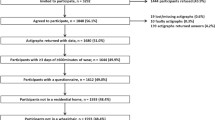Summary.
Physical activity is usually considered as an important component of a healthy lifestyle, including a preventive effect on the risk of falls in the elderly. The relationship between physical activity and falls is complex: physical activity is a prerequisite to maintain neuromuscular functioning, necessary to keep balance and to react to a fall, but a higher level of physical activity also implies a greater exposure to environmental threats, possibly leading to a fall. Related to this greater exposure to threats, the use of a walking aid may protect against falls in those who have impaired mobility. In this cross-sectional study we investigated the relationship between daily physical activity and falls and the use of a walking aid in elderly subjects. Participants were 131 men and 563 women, aged 70years and over (mean age and standard deviation: 82±6 years), living in homes for the elderly (n=335) and apartment houses for elderly (n=359). Data on baseline characteristics and falls in the previous year were obtained using a questionnaire. The level of daily physical activity in the previous year was obtained by means of a questionnaire regarding household and leisure activities. Subjects with a lower extremity fracture in the previous year were excluded from the analyses. Data were analysed using multiple logistic regression, adjusted for age, gender, and residence. In the past year, 40% of the participants fell at least one time, and 19% of the participants fell two times or more. Since falls and recurrent falls were nonlinearly related to the level of daily physical activity, the physical activity score was grouped into quartiles: the highest quartile corresponding to the highest activity level. Odds ratios (and 95% confidence intervals) for falls and recurrent falls for subjects in the highest quartile contrasted with those in the lowest quartile were 0.5 (0.3–0.9) and 0.3 (0.2–0.6), respectively. The risk of falls and recurrent falls was not lower for those with intermediate levels of daily physical activity. The use of a walking aid protected against falls in those with intermediate high activity levels (third quartile). It was suggested that the exposure to environmental hazards, due to some degree of physical activity may have been responsible for the nonlinear relationship between daily physical activity and falling. We conclude that a high activity level and the use of a walking aid may protect against falls.
Zusammenfassung.
Körperliche Aktivitäten stellen einen wichtigen Bestandteil für einen gesunden Lebensstil dar. Dies gilt auch für die Sturzprävention. Der Zusammenhang zwischen körperlicher Aktivität und Stürzen ist komplex. Körperliche Aktivität ist zum einen notwendig um die neuromuskuläre Funktion und Balance aufrechtzuerhalten und um auf einen Sturz zu reagieren, aber ein höheres Ausmaß körperlicher Aktivität bedeutet auch ein größeres Risiko aufgrund der Umgebungssituation zu stürzen. Gehhilfen stellen möglicherweise einen Schutz vor Stürzen bei gehbehinderten Menschen dar. In einer Querschnittsuntersuchung wurde daher der Zusammenhang zwischen täglicher körperlicher Aktivität und Stürzen und dem Gebrauch von Gehhilfen bei älteren Menschen untersucht. Teilnehmer der Studie waren 131 Männer und 563 Frauen, 70 Jahre und älter (mittleres Alter 62±6 Jahre), die in Altenheimen (N=335) und Betreutem Wohnen (N=359) lebten. Grundlegende Daten und die Sturzhäufigkeit im vergangenen Jahr wurde durch einen Fragebogen ermittelt, ebenso die durchschnittlichen täglichen körperlichen Aktivitäten. Personen mit einer Fraktur der unteren Extremität im vergangen Jahr wurden von der Untersuchung ausgeschlossen. Die Daten wurden durch multiple logistische Regression angepasst für Alter, Geschlecht und Wohnort analysiert. Im letzten Jahr stürzten 40% der Teilnehmer mindestens einmal und 19% der Teilnehmer zweimal oder mehr. Da Stürze und wiederholte Stürze nicht linear mit dem Ausmaß körperlicher Aktivität verknüpft sind, wurde der körperliche Aktivitätsscore in Quartilen unterteilt, wobei die höchste Quartile den höchsten Aktivitätslevel widerspiegelt. Die Odds-ratio (und 95% Konfidenzintervalle) für Stürze und wiederholte Stürze kontrastierten mit 0,5 (0,3–0,9) in der höchsten Quartile verglichen mit der niedrigsten Quartile, die ein Verhältnis von 0,3 (0,2–0,6) aufwies. Das Risiko für Sturz und wiederholte Stürze war für Teilnehmer mit mittlerem Aktivitätsniveau nicht geringer. Der Gebrauch von Gehhilfen stellte in der Gruppe mit intermediärem bis hohem körperlichem Aktivitätslevel (3. Quartile) einen Schutz vor Stürzen dar. Es wird vermutet, dass Umgebungsrisiken verbunden mit einem gewissen Maß körperlicher Aktivität verantwortlich sind für die nichtlineare Verbindung zwischen täglicher körperlicher Aktivität und Stürzen. Ein hoher Aktivitätslevel und der Gebrauch von Gehhilfen kann dazu beitragen, Stürze zu vermeiden.
Similar content being viewed by others
Author information
Authors and Affiliations
Additional information
Received: 28 October 2002 Accepted: 15 November 2002
Correspondence to W. C. Graafmans
Rights and permissions
About this article
Cite this article
Graafmans, W., Lips, P., Wijlhuizen, G. et al. Daily physical activity and the use of a walking aid in relation to falls in elderly people in a residential care setting. Z Gerontol Geriat 36, 23–28 (2003). https://doi.org/10.1007/s00391-003-0143-8
Issue Date:
DOI: https://doi.org/10.1007/s00391-003-0143-8




